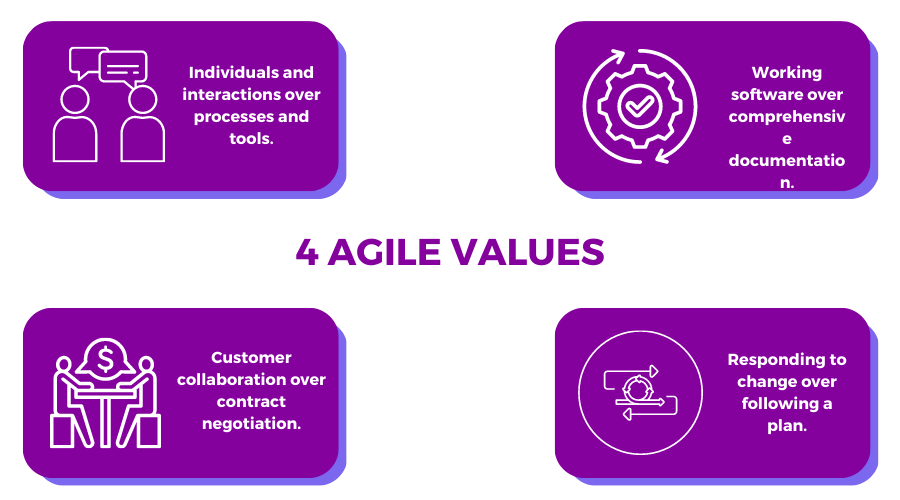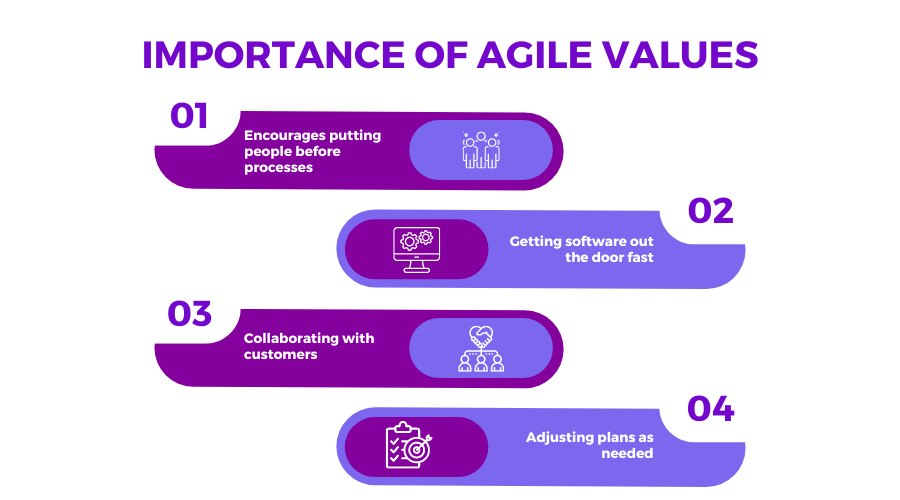
What Does Value Mean in Agile?
Agile values definition:
The Agile values are those articulated in the Agile Manifesto. They prioritize people over processes, working software over documentation, customer cooperation over contract negotiations, and adapting to change over sticking to a plan.
Software companies are on the rise in today’s day and age. And one framework that most of them follow is the Agile Manifesto.
The Agile Manifesto outlines values, principles, and practices for project and product management agility.
The four values of Agile lay out a broad approach one should take toward any project. In today’s post, let’s look at the four Agile values and how you can apply them.
First, let’s begin by understanding what ‘value’ means in Agile.
In Agile, ‘value’ refers to a way of working. Agile values aren’t rules but rather guidelines.
The values capture the ethos of Agile and put forward a broad, suggestive road to walk on. Unlike Agile principles, the values are open to interpretation.
While they are essentially outlined for software companies, they easily apply to any business.
As businesses strive to move from traditional waterfall to Agile methodologies, the Agile values are an excellent place to start. This is because they don’t focus on specific practices but rather holistic approaches toward product management.
Thus, values in Agile refer to a way of approaching your project management style.
Let’s learn about the four Agile values now!
The 4 Values of the Agile Manifesto
The Agile Alliance outlined four values in The Agile Manifesto, which we refer to as the Agile Values.
This set of values promotes putting people first, releasing software quickly, collaborating with customers, and adjusting plans as needed.
The four Agile values are as follows:
- Individuals and interactions over processes and tools.
- Working software over comprehensive documentation.
- Customer collaboration over contract negotiation:
- Responding to change over following a plan.
The four Agile values make up the essence of the Agile Manifesto. All other Agile principles are based on them.

Let’s look at each of these values in detail.
Individuals and Interactions Over Processes and Tools
People are at the center of the Manifesto. The most valuable resource for any Agile team is its people.
Yes, you are free to conduct as much research and preparation as possible. You can even spend money on cutting-edge technology. However, the success or failure of your project ultimately depends on the people involved.
Your processes and tools add up to nothing if the individual or team behind them is inefficient.
This is not to say that Agile philosophies oppose formalized processes and tools. Both can help your team get organized and interact more effectively. But, in the end, they are a distant second.
After all, product management tools are useless if your team cannot communicate effectively.
Put an innovative, motivated team in charge of a project without processes or tools to manage it. They’ll probably figure out a way to finish it.
Working Software Over Comprehensive Documentation
Traditional product development needs you to prepare extensive documentation before coding even a quarter of a program. However, the Agile philosophy prioritizes product delivery.
Think about it. How will you enhance your product if you don’t put it out there and receive input from actual users?
While documentation isn’t a bad thing, there comes the point when you should focus on providing your customers with working software.
This is why product managers prioritize a minimum viable product and run iterations these days. It helps gather user feedback and product analytics for improvement.
Customer Collaboration Over Contract Negotiation
Agile values emphasize a customer-led strategy over a product-led strategy.
Of course, contracts are an essential business tool. But they never take precedence over your customers’ real needs.
Suppose a company and its customers lay out everything that needs to be done ahead of time. In that case, the product developer will have little room for improvisation. A developer may lose sight of their product vision if they do not work closely with their customers.
You must create a feedback loop with your customers to ensure that your product continues to meet their needs.
Continuous development should be the priority, according to the Agile Manifesto.
Contracts won’t tell you what your users need. Your users will tell you themselves. What is the point of contracts if your final product fails to solve user problems?
Responding To Change Over Following a Plan
Usually, product owners confuse the phrase “the show must go on” with “whatever happens, stick to the plan.”
The problem with that approach is that it leaves no room for change management.
Needs and requirements change over time, and priorities shift as well. That fixed roadmap will quickly become obsolete.
That’s why, according to the Agile Manifesto, a software team should be able to adjust and change direction at any time with a flexible roadmap. A dynamic roadmap can change every quarter or month, and Agile teams can adapt to these changes.
As a result, the product roadmap is no longer a permanent blueprint but rather a dynamic plan.
Product managers in Agile settings must learn to deliver dynamic roadmaps to stakeholders in a clear manner that represents the possibility of change based on new insights.

How Can You Apply Agile Values to Your Projects?
Agile methodologies help produce better, higher-quality products for clients in a more timely manner.
Here’s how you can apply the Agile values to your projects:
Communicate Openly
Agile principles emphasize face-to-face communication.
Do you and your colleagues engage in face-to-face discussions? Or do you rely on emails, documents, and certain well-liked messaging applications?
Consider how you can promote settings where your team can form relationships and become more accustomed to face-to-face communication. Consider a lunch outing or a topic discussion.
Even if you operate remotely, having a face-to-face chat might help things move more quickly. It promotes trust, transparency, and relationship development.
Ease The Process
When you choose efficient product management tools, you don’t have to worry much about the process.
This helps you focus on your team. Your user doesn’t care about your tools and processes. What they do care about is how well your company understands them. And this needs a team with customer empathy.
Try a product management software that handles everything for you so that you can manage your people.
Jump Into Development
It’s wonderful to write streams of requirements documents and map out all of the industry’s requirements, clients, and customers.
However, seeing something functioning, responding, and adapting is more practical.
Consider the following methods for moving your project along quickly:
- Put a deadline on product discovery.
- Organize workshops.
- Use a dynamic product roadmap.
- Focus on a minimum viable product (MVP).
- Change your plans to see what works best for you.
Continuous Integration and Deployment
Continuous integration and continuous deployment help make product delivery more efficient and quick.
With continuous integration, you make sure all your developers’ codes are compatible with each other. This leads to fewer bugs and errors.
Continuous deployment automates your release process, so software developers can focus on developing functional products and not worry about their release.
It is recommended that you use such Agile best practices as a way to be more customer-centric.
Agile Values Application Examples
Agile values are an approach to your work. You may apply them to one or all aspects.
Here are some Agile value application examples:
- Get rid of complex product management tools if your team finds them difficult to work with.
- Opt for a product management software that fosters team collaboration.
- Conduct team-building exercises.
- Develop roadmaps that result in cross-functional teams.
- Don’t be rigid about deadlines. Let your team work creatively.
- Product managers must delegate rather than overtake.
- Switch product requirements documentation with a requirements meeting, so everyone is actively involved.
- Take user feedback seriously and frequently.
- Engage in idea management practices.
- Focus on resource capacity planning.
These are some examples of the application of Agile values. But again, these examples aren’t set in stone, just like the values.
The Agile methodology can significantly enhance outcomes in software development and other projects.
So, suppose you’re moving to the Agile approach. In that case, you must commit to the Agile values and principles to achieve new heights in customer success.
But you can’t meet your customers’ needs with clumsy, out-of-date product management tools.
You’ll need robust, Agile product management software such as Chisel!
It includes all of the features you need to improve efficiency and transparency, making it ideal for Agile product management.
Sign up for Chisel today to help your team succeed on every assignment!
